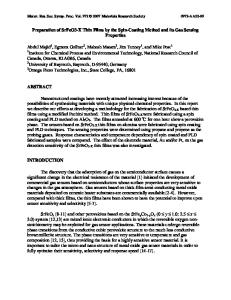The effect of Yb doping on ZnO thin films obtained via a low-temperature spin coating method
- PDF / 2,422,047 Bytes
- 13 Pages / 595.276 x 790.866 pts Page_size
- 103 Downloads / 809 Views
The effect of Yb doping on ZnO thin films obtained via a low-temperature spin coating method Edgar R. Lo´pez-Mena1,* , O. Ceballos-Sanchez2, T. J. N. Hooper3, Gildardo Sanchez-Ante4, Mateo Rodrı´guez-Mun˜oz5, Jose A. Renteria-Salcedo1, Alex Elı´as-Zun˜iga1, and A. Sanchez-Martinez6,* 1
Tecnologico de Monterrey, Escuela de Ingeniería Y Ciencias, Campus Monterrey, 64849 Monterrey, Nuevo León, Mexico Departamento de Ingeniería de Proyectos, CUCEI, Universidad de Guadalajara, Av. José Guadalupe Zuno # 48, Industrial Los Belenes, 45157 Zapopan, Jalisco, Mexico 3 Energy Research Institute @ NTU, Nanyang Technological University, 50 Nanyang Drive, X-Frontiers Block, Level 5, Singapore 637553, Singapore 4 Universidad Politécnica de Yucatán, Carretera Merida-Tetiz, Km. 4.5, 97357 Ucu, YUC, México 5 Department of Chemical and Environmental Engineering, Universidad Nacional de Colombia, Carrera 30 No. 45-03, Bogotá, D.C, Colombia 6 CONACYT-Departamento de Ingeniería de Proyectos, CUCEI, Universidad de Guadalajara, Av. José Guadalupe Zuno # 48, Industrial Los Belenes, 45157 Zapopan, Jalisco, Mexico 2
Received: 5 August 2020
ABSTRACT
Accepted: 28 October 2020
The spin coating method was employed to fabricate Yb-doped ZnO thin films at 0, 3, 5, 7, and 9 at.% over a glass substrate at low temperature. X-ray diffraction analysis revealed that the hexagonal wurtzite structure was retained even at high doping contents. With the incorporation of Yb?3 ions, a slight decrease in the lattice parameters and crystallite size was observed as the ytterbium content increased. X-ray photoelectron spectroscopy confirmed the presence of ytterbium in the doped ZnO films, and the oxidation state of ytterbium was 3? for all the samples. Morphological studies revealed a surface microstructure formed by micro islands, which tended to be denser as the ytterbium content increased. Optical transmittance was observed at approximately 75–85%, a blueshift was observed, and consequently, an increase in the bandgap, which varies from 3.0 to 3.2 eV, was observed. The refractive index and extinction coefficient decreased as the ytterbium dopant concentration increased. The photoluminescence results exhibited a strong ultraviolet emission, allowing the use of these thin films in optoelectronic applications.
Ó
Springer Science+Business
Media, LLC, part of Springer Nature 2020
Address correspondence to E-mail: [email protected]; [email protected]
https://doi.org/10.1007/s10854-020-04785-7
J Mater Sci: Mater Electron
1 Introduction ZnO is an n-type semiconductor with a direct wide bandgap (3.3 eV), large exciton binding energy (60 meV) and high optical gain (320 cm-1) at room temperature, as well as interesting electrical, structural and optoelectronic properties [1–4]. ZnO has been used for applications such as light emitting diodes (LEDs), gas sensors, field-effect transistors, and photovoltaic devices and as a photocatalyst in environmental photocatalysis and medicine [5–10]. In recent years, metal oxides (ZnO, TiO2, SnO2, CdO, CuO, etc.) have been d
Data Loading...











